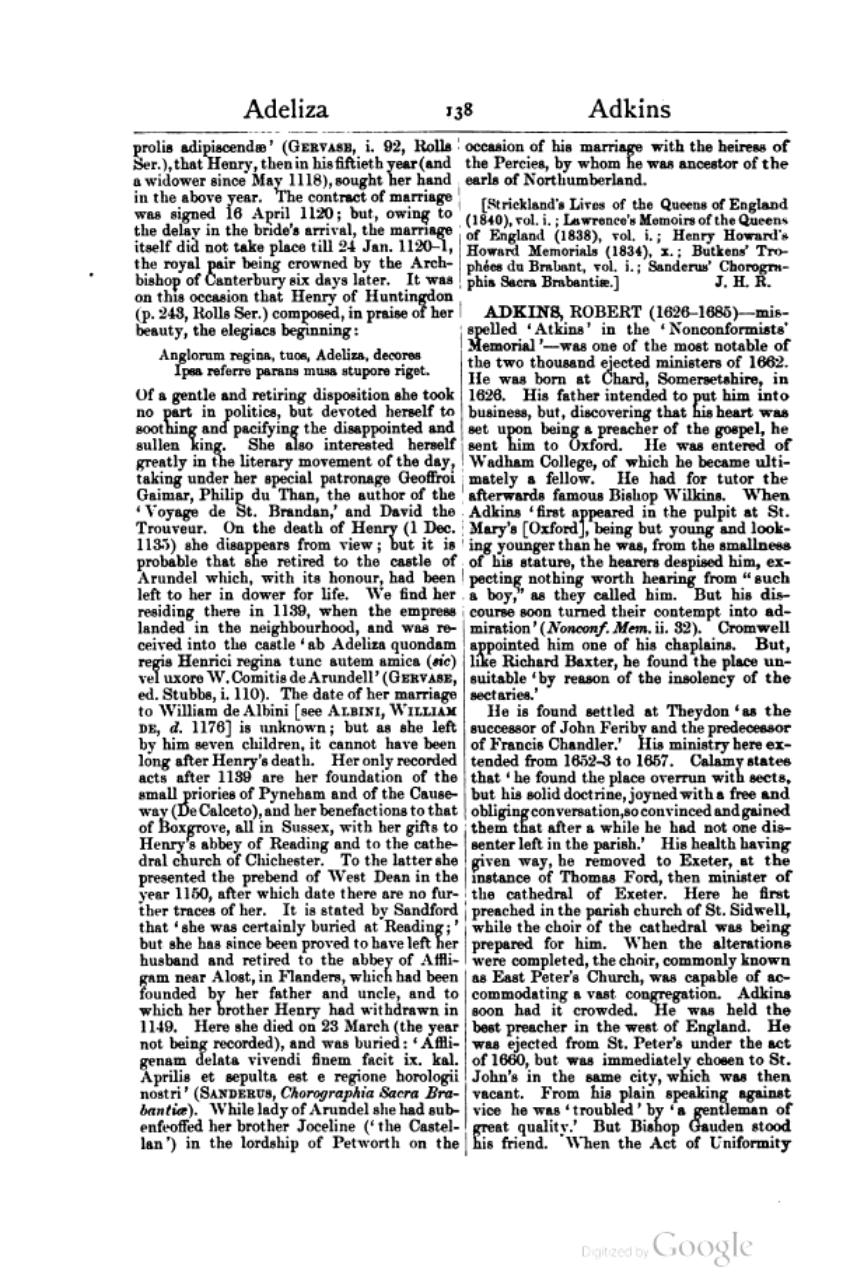prolis adipiscendæ’ (Gervase, i. 92, Rolls Ser.), that Henry, then in his fiftieth year (and a widower since May 1118), sought her hand in the above year. The contract of marriage was signed 16 April 1120; but, owing to the delay in the bride's arrival, the marriage itself did not take place till 24 Jan. 1120–1, the royal pair being crowned by the Archbishop of Canterbury six days later. It was on this occasion that Henry of Huntingdon (p. 243, Rolls Ser.) composed, in praise of her beauty, the elegiacs beginning:
Anglorum regina, tuos, Adeliza, decores
Ipsa referre parans musa stupore riget.
Of a gentle and retiring disposition she took no part in politics, but devoted herself to soothing and pacifying the disappointed and sullen king. She also interested herself greatly in the literary movement of the day, taking under her special patronage Geoffroi Gaimar, Philip du Than, the author of the ‘Voyage de St. Brandan,’ and David the Trouveur. On the death of Henry (1 Dec. 1135) she disappears from view; but it is probable that she retired to the castle of Arundel which, with its honour, had been left to her in dower for life. We find her residing there in 1139, when the empress landed in the neighbourhood, and was received into the castle ‘ab Adeliza quondam regis Henrici regina tunc autem amica (sic) vel uxore W. Comitis de Arundell’ (Gervase, ed. Stubbs, i. 110). The date of her marriage to William de Albini [see Albini, William de, d. 1176] is unknown; but as she left by him seven children, it cannot have been long after Henry's death. Her only recorded acts after 1139 are her foundation of the small priories of Pyneham and of the Causeway (De Calceto), and her benefactions to that of Boxgrove, all in Sussex, with her gifts to Henry's abbey of Reading and to the cathedral church of Chichester. To the latter she presented the prebend of West Dean in the year 1150, after which date there are no further traces of her. It is stated by Sandford that ‘she was certainly buried at Reading;’ but she has since been proved to have left her husband and retired to the abbey of Affligam near Alost, in Flanders, which had been founded by her father and uncle, and to which her brother Henry had withdrawn in 1149. Here she died on 23 March (the year not being recorded), and was buried: ‘Affligenam delata vivendi finem facit ix. kal. Aprilis et sepulta est e regione horologii nostri’ (Sanderus, Chorographia Sacra Brabantiæ). While lady of Arundel she had sub-enfeoffed her brother Joceline (‘the Castellan’) in the lordship of Petworth on the occasion of his marriage with the heiress of the Percies, by whom he was ancestor of the earls of Northumberland.
[Strickland's Lives of the Queens of England (1840), vol. i.; Lawrence's Memoirs of the Queens of England (1838), vol. i.; Henry Howard's Howard Memorials (1834), x.; Butkens' Trophées du Brabant, vol. i.; Sanderus' Chorographia Sacra Brabantiæ.]
ADKINS, ROBERT (1626–1685)—misspelled ‘Atkins’ in the ‘Nonconformists' Memorial’—was one of the most notable of the two thousand ejected ministers of 1662. He was born at Chard, Somersetshire, in 1626. His father intended to put him into business, but, discovering that his heart was set upon being a preacher of the gospel, he sent him to Oxford. He was entered of Wadham College, of which he became ultimately a fellow. He had for tutor the afterwards famous Bishop Wilkins. When Adkins ‘first appeared in the pulpit at St. Mary's [Oxford], being but young and looking younger than he was, from the smallness of his stature, the hearers despised him, expecting nothing worth hearing from “such a boy,” as they called him. But his discourse soon turned their contempt into admiration’ (Nonconf. Mem. ii. 32). Cromwell appointed him one of his chaplains. But, like Richard Baxter, he found the place unsuitable ‘by reason of the insolency of the sectaries.’ He is found settled at Theydon ‘as the successor of John Feriby and the predecessor of Francis Chandler.’ His ministry here extended from 1652–3 to 1657. Calamy states that ‘he found the place overrun with sects, but his solid doctrine, joyned with a free and obliging conversation, so convinced and gained them that after a while he had not one dissenter left in the parish.’ His health having given way, he removed to Exeter, at the instance of Thomas Ford, then minister of the cathedral of Exeter. Here he first preached in the parish church of St. Sidwell, while the choir of the cathedral was being prepared for him. When the alterations were completed, the choir, commonly known as East Peter's Church, was capable of accommodating a vast congregation. Adkins soon had it crowded. He was held the best preacher in the west of England. He was ejected from St. Peter's under the act of 1660, but was immediately chosen to St. John's in the same city, which was then vacant. From his plain speaking against vice he was ‘troubled’ by ‘a gentleman of great quality.’ But Bishop Gauden stood his friend. When the Act of Uniformity
